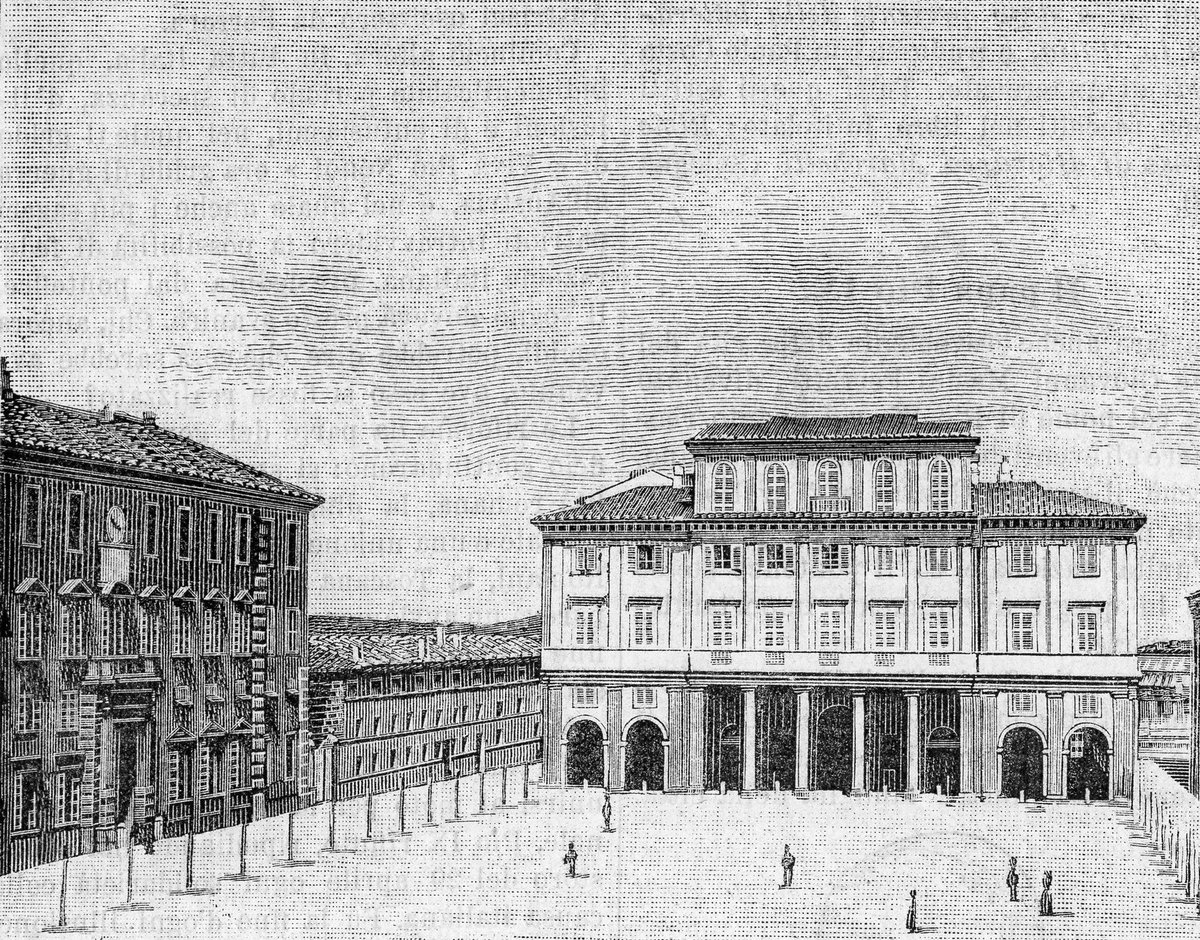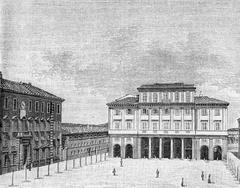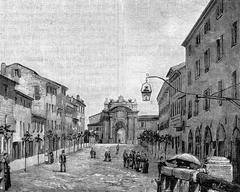
Episcopal Palace Senigallia: Visiting Hours, Tickets, and Historical Sites Guide
Date: 14/06/2025
Introduction
Nestled in the historic heart of Senigallia, in Italy’s picturesque Marche region, the Episcopal Palace (Palazzo Vescovile) stands as a testament to centuries of religious, cultural, and architectural evolution. Originally built as the residence and administrative center for the city’s bishops, the palace offers visitors an immersive journey through Senigallia’s ecclesiastical past, Renaissance artistry, and ongoing heritage preservation. Its central location, near landmarks such as the Rocca Roveresca, Cattedrale di San Pietro Apostolo, and Foro Annonario, makes it an essential stop for those seeking to experience the city’s rich historical fabric (Senigallia Urban Archaeological Project; Britannica; Trip101; Italia.it).
This comprehensive guide details the palace’s history, architectural highlights, visiting hours, ticketing options, accessibility, and practical travel tips. Whether you are a history enthusiast, art lover, or cultural traveler, this resource will help you plan a memorable visit to one of Senigallia’s most treasured historical sites.
Historical Development of the Episcopal Palace
Ancient and Early Christian Roots
The site of the Episcopal Palace has been sacred since at least the 3rd century BCE, with archaeological evidence revealing the presence of an ancient sanctuary. Early religious practices here included fertility rites and rituals associated with water and renewal, as evidenced by votive offerings and ritual pits found on site. During Roman times, the sanctuary was integrated into the city’s urban grid, reflecting a blend of local Italic and Roman religious traditions, and the area continued as a focal point for communal and spiritual life (Senigallia Urban Archaeological Project).
With Christianization, the site transformed into the heart of ecclesiastical power for the region. The palace, built adjacent to the cathedral, became the bishop’s residence and administrative headquarters, symbolizing the enduring influence of the Church on Senigallia’s identity (Britannica).
Renaissance and Baroque Flourishing
The palace underwent significant development during the Renaissance and Baroque periods, particularly under the patronage of the Della Rovere family in the late 15th century. Their influence is reflected in the palace’s elegant architectural features and in its role as a venue for ecclesiastical courts and official receptions. The proximity to other landmarks, such as the Rocca Roveresca and Cattedrale di San Pietro Apostolo, consolidated its status as the city’s spiritual and administrative hub (Trip101).
18th–19th Century Restoration and Modern Preservation
The palace’s importance continued under the Papal States, with 18th and 19th-century renovations introducing neoclassical elements. Following Italian unification, the palace shifted from purely ecclesiastical functions to a focus on heritage preservation and public engagement. Today, it remains a vital symbol of Senigallia’s layered history and ongoing cultural vitality.
Architectural and Artistic Highlights
Exterior and Urban Integration
The Episcopal Palace features a harmonious façade, characterized by symmetrical window arrangements, elegant portals, and decorative ecclesiastical insignia. Its design seamlessly integrates with the surrounding urban landscape, complementing the nearby Rocca Roveresca and Piazza del Duca (Trip101).
Interior Features and Collections
Inside, visitors encounter:
- Frescoes: Notable works by artists such as Federico Barocci and Antonio Viviani, depicting biblical scenes and local history (Triplyzer).
- Antique Furnishings: Period furniture, tapestries, and liturgical objects reflecting the tastes and traditions of Senigallia’s bishops.
- Private Chapel: Featuring intricate stucco decoration and stained glass.
The palace also houses museum exhibits on diocesan history and religious art, with temporary exhibitions highlighting local culture (Overyourplace).
Visiting the Episcopal Palace: Practical Information
Opening Hours
- General Schedule: Tuesday–Sunday, 10:00 AM–6:00 PM
- Closures: Mondays and public holidays. Hours may vary for events or seasonally; always confirm via the official Senigallia tourism website or local visitor center.
Tickets and Admission
- Standard Admission: €8 (adults)
- Reduced Admission: €5 (seniors, students, groups)
- Children under 12: Free
- Tickets: Available at the entrance or online via the official Senigallia tourism website. Combination tickets for multiple sites are sometimes offered.
Accessibility
The palace is partially accessible, with ramps and elevators serving most areas. Some historic rooms may require stair access; visitors with mobility concerns should inquire in advance.
Guided Tours
- Languages: Italian and English (other languages may be available upon request)
- Schedule: Daily at 11:00 AM and 3:00 PM
- Booking: Recommended via the tourist office or palace entrance
- Content: Detailed historical, architectural, and artistic insights
Visitor Etiquette
- Dress Code: Modest attire is advised, especially for chapel visits (shoulders and knees covered).
- Photography: Permitted in most areas without flash or tripods. Restrictions may apply in the chapel or during exhibitions.
- Facilities: Restrooms and a small gift shop are available.
Highlights of the Visitor Experience
- Renaissance Architecture: Admire the harmonious façade, grand staircases, and ornate interiors.
- Frescoed Rooms: View masterpieces by Barocci and Viviani.
- Historic Ambience: Enjoy tranquil, naturally lit spaces ideal for contemplation and photography.
- Museum Displays: Explore religious art, archival documents, and liturgical objects.
- Central Location: Easily combine your visit with nearby attractions, restaurants, and shops.
Top Nearby Attractions
- Rocca Roveresca: Impressive Renaissance fortress with panoramic views (Italia.it).
- Palazzetto Baviera: Renowned for stucco ceilings by Federico Brandani (The Crowded Planet).
- Foro Annonario: Neoclassical market square with daily markets and fairs.
- Piazza Garibaldi: Main square with historic buildings and cafés (Triplyzer).
- Portici Ercolani: 18th-century arcades along the Misa River (Anita Villas).
- La Rotonda a Mare: Iconic seaside pavilion (Feel Senigallia).
- Cattedrale di San Pietro Apostolo: Senigallia’s neoclassical cathedral (Anita Villas).
Seasonal Events and Local Culture
- Summer Jamboree (August): International festival of 1940s-50s American music and culture (Summer Jamboree).
- Local Markets: Daily at Foro Annonario; antiques fairs and food festivals year-round.
- Other Events: RDS Show in June, Biennale di Senigallia, and open-air concerts (Feel Senigallia).
Best Visiting Periods: Late spring to early autumn (May–October) for mild weather and cultural activities. Early mornings and weekdays are less crowded (Weather and Climate).
Essential Visitor Tips
- Plan Ahead: Double-check opening hours and book tickets in advance during peak seasons or major events.
- Getting There: Senigallia is accessible by train, bus, and car. Parking is available near the historic center; cycling and walking are excellent ways to explore.
- Dress and Comfort: Wear comfortable shoes for cobblestone streets and bring a light jacket or umbrella in case of rain.
- Language: Staff and guides speak Italian and English; printed guides available in multiple languages (Overyourplace).
- Amenities: Numerous restaurants, cafés, and shops are within walking distance.
Frequently Asked Questions (FAQ)
Q: What are the latest Episcopal Palace visiting hours?
A: Typically Tuesday–Sunday, 10:00 AM–6:00 PM, but check the official website for updates.
Q: Where can I purchase tickets?
A: At the palace entrance or online via the official Senigallia tourism website.
Q: Is the palace accessible for visitors with mobility challenges?
A: Largely accessible, with some historic areas requiring stairs. Contact ahead for support.
Q: Are guided tours available in English?
A: Yes, tours are typically offered in Italian and English.
Q: Can I take photographs inside?
A: Yes, except in certain areas or during special events. Flash and tripods are usually prohibited.
Q: What are other must-see attractions nearby?
A: Rocca Roveresca, Palazzetto Baviera, Foro Annonario, Piazza Garibaldi, and La Rotonda a Mare.
Conclusion
The Episcopal Palace Senigallia stands as a remarkable intersection of ancient sanctity, Renaissance elegance, and vibrant modern life. Its rich history, exquisite art, and central location make it one of Senigallia’s most rewarding destinations. For the best experience, check current visiting hours and ticket options, consider a guided tour, and explore the surrounding historical sites and cultural events.
For up-to-date information, download the Audiala mobile app, visit the official Senigallia tourism website, and follow local tourism channels on social media. The Episcopal Palace awaits—your gateway to the timeless spirit of Senigallia and the Marche.
Sources and Further Reading
- Trip101: Things to Do in Senigallia
- Senigallia Urban Archaeological Project
- Triplyzer: Things to Do in Senigallia
- Summer Jamboree Festival
- Britannica: Senigallia
- Italia.it: Senigallia
- Overyourplace: What to See in Senigallia
- The Crowded Planet: Visit Senigallia
- Anita Villas: Things to Do in Senigallia
- Summer in Italy: Senigallia Guide
- Feel Senigallia
- Weather and Climate: Senigallia Averages
- Climate Data: Senigallia

